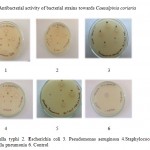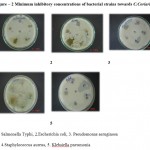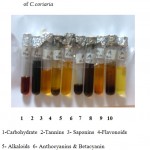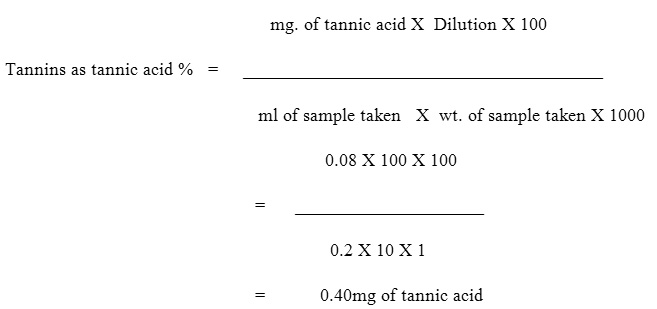How to Cite | Publication History | PlumX Article Matrix
Antibacterial Activity of Caesalpinia coriaria
D. Anandhi1, P.T. Srinivasan1, K.Revathi2* and E.K. Revathy1
1Department of Biochemistry,D.G.Vaishnav College, Arumbakkam, Chennai - 600 106 India.
2Department of Zoology, Ethiraj College for Women, Chennai - 600 008 India.
Corresponding Auhthor E-mail: sivaanandhi11@yahoo.com
ABSTRACT: In the present study the powdered pod material of Caesalpinia coriaria (Jacq) wild was extracted with water acetone methanol and hexane. The antibacterial activity assays of all the extracts against the important human pathogens like Salmonella Typhimuriun, Escherichia coli, Pseudomonas aeruginosa, Methicillin resistant Staphylococcus aureus, and Klebsiella pneumonia were carried by bore well method. Acetone method shows significant activity. Phytochemical and quantitative studies of pod material revealed that antibacterial activity is due to the presence of tannin fraction. The result suggests that Caesalpinia coriaria is a potential candidate plant for the management of organism for antibacterial activity.
KEYWORDS: Antibacterial activity; Caesalpinia coriaria
Download this article as:| Copy the following to cite this article: Anandhi D, Srinivasan P. T, Revathi K, Revathy E. K. Antibacterial Activity of Caesalpinia coriaria. Biosci Biotech Res Asia 2011;8(2) |
| Copy the following to cite this URL: Anandhi D, Srinivasan P. T, Revathi K, Revathy E. K. Antibacterial Activity of Caesalpinia coriaria. Biosci Biotech Res Asia 2011;8(2). Available from: https://www.biotech-asia.org/?p=9613 |
The earliest mention of the medicinal use of plants is found in the Rig-Veda. During the centuries that have gone by the materica medica of the indigenous systems of medicine has become extensive and heterogeneous (Frabricant D.S, 2001). The practitioners of various Indian systems in different parts of India tried to utilize the locally growing plants as for as possible and accepted those which were found useful after trial for treatment of disease. (Chopra R.N, 1998)
For centuries plants are used throughout the world as drugs and remedies for various diseases (UNESCO, 1996). Recently, much attention is directed towards extracts and biologically active compounds isolated from popular plant species (YoganarJ.D, 1982). The use of medicinal plants play a vital role in covering the basic health needs in developing countries and these plants may offer a new source of antibacterial, antifungal and antiviral agent with significant activity against infective microorganism( (Kiritikar K.R, 1989).
In the last few years, a number of studies are conducted in different countries to prove their efficacy. Caesalpinia coriaria is a small tree, stem without prickles, leaves with 6-8 pairs of pinnae. Flowers are small light yellow or green sweet scented in short dense panicle pods all thick twisted not covered with prickle. Pods are astringent. The powder of pods is antiperiodicals; the decoction of pod is used in the treatment of bleeding piles (Wealth, 1972). The pods are rich in tannins, this belongs to polyphenol compounds may be classified according to the nature of the product of hydrolysis and some of their chemical reactions, and the true tannins will convert animal hides into leather (Baxter N.J, 1997). Tannins is mostly located in the spongy tissue below the epidermis, It is frequently lost when the epidermis is ruptures in collection, handling or storage (Terill T.H, 1992). All parts of the plant contain tannin, the maximum amount occuring in the pods (69.4 %) (Haslam E, 1996)
Collection of Plant Material
Dry pods of Caesalpinia coriaria free from diseases were collected from Captain Srinivasa Drug Research Institute, Arumbakkam, Chennai, cleaned, shade dried, powdered finely using a blender and used for extraction. All the chemicals and reagents for the experiments used were purchased from Loba chemie, Merck, Qualigens.
Materials and Method
Extraction of Plant Materials
Preparation of aqueous, acetone, methanol and hexane extracts using Soxhlet apparatus. (Franz von Soxhlet, 1879)
Ten grams of shade dried, powdered pods of C.coriaria were weighed and rolled in gauss cloth. Both the ends of the cloth were tied using thick thread or twine and placed in the thimble part of the Soxhlet apparatus.150ml of the respective solvents for extract namely sterile distilled water, acetone, methanol, and hexane were taken in the still pot of the apparatus each time. Both the thimble and still pot were assembled with the condenser and heated to reflux for three cycles. The extract thus obtained was filtered using gauss cloth and poured into large petriplates. It was kept on a hot plate maintained at 20-60oC until the extract gets completely dried. The dried extracts were scrapped of using clean spatula and stored in sterile microfuge tubes in freezer for further use.
Antibacterial Activity Assay
(Agar Well Diffusion Method)
This activity was evaluated by taking Caesalpinia coriaria pod extracts prepared using sterile distilled water, acetone, methanol, and hexane.1mg of each dried extract sample was weighed accurately and dissolved in 1ml of DMSO. DMSO (Dimethyl sulfoxide) was taken as control. Bacteria’s like Salmonella Typhimurium (Clinical isolate), Escherichia coli MTTC 443, Pseudomonas aeruginosa MTTC 2433, Methicillin resistant Staphylococcus aureus (Clinical isolate), and Klebsiella pneumonia (Clinical isolate) were used for this assay.
Each organism incubated in peptone water for 4 hours were taken in a sterile swab and swabbed in respective petriplates containing MH Agar. Five bores were made in each plate containing one respective organism using cork borer. 20µl of each extract and 20µl of DMSO were added in respective bores. Thus, each plate containing one organism and all the 4 extracts and DMSO as a control were labeled and incubated for overnight. The zones formed around each bore containing respective extract and control, in the all plates containing respective organisms were measured and noted down.
Minimum Inhibitory Concentration Assay
This activity was evaluated by taking Caesalpinia coriaria pod extract prepared using acetone. Bacteria were Salmonella Typhimurium, Escherichia coli, Pseudomonas aeruginosa, Methicillin resistant Staphylococcus aureus, Klebsiella pneumonia were used for this assay.
Each organism incubated in peptone water for 4 hours were taken in a sterile swab inside LAF and swabbed in respective petriplates containing MH Agar. Five bores were made in each plate containing one respective organism using cork borer. 10µl, 15µl, 20µl, 25µl, 30µl of extract were added in respective bores for each organism. The zones formed around each bore containing respective concentration of the extract, in the all plates containing respective organisms were measured and noted down.
Phytochemical Evaluation
Test for tannins, carbohydrates, saponins, flavonoids, alkaloids, glycosides, protein and amino acids (by biuret test and ninhydrin test), anthocyanins and betacyanins were carried out.
Estimation Of Tannin By Folin Denis Method
0.2 to 1ml aliquots of standard tannic acid solution and 0.2ml of acetone extract was pipette into 100ml volumetric flask containing 75ml of distilled water, 5ml of Folin Denis reagent and 10ml of saturated sodium carbonate solution were added into each of the volumetric flask and made up to 100ml with distilled water. The contents were mixed well and the blue colour developed after 30 minutes was read spectrophotometrically at 760nm.
Thin Layer Chromatography Method
The TLC methods were carried out by using Silica gel G by mixing the extract with aqueous, chloroform and methanol. This solution was developed using solvent chloroform: acetone in the ratio 1:1.5(Fried B, 1994).
Results and Discussion
Antibacterial Activity Assay
(Agar Well Diffusion Method)
Plate exhibiting the inhibitory activity of the plant extract (acetone, aqueous, methanol, and hexane) of C. coriaria on
Salmonella Typhi,
Escherichia coli,
Pseudomonas aeruginosa,
Staphylococcus aureus,
Klebsiella pneumonia and
Control was shown in table 1.
Table 1: Antibacterial activity of Caesalpinia coriaria.
| S.
NO |
EXTRACT | INHIBITION ZONE(mm) | ||||||
| ORGANISM | ||||||||
| 1. | TEST | Dilution (ml) | DMSO (ml) | S.Typhi | E.coli | P.aeruginosa | S.aureus | K.pneumonia |
| Acetone | 0.02) | – | 8.5 | 9.0 | 6.0 | 10.0 | 9.0 | |
| Aqueous | 0.02 | – | 6.0 | 7.0 | – | 8.0 | 7.0 | |
| Methanol | 0.02 | – | 8.5 | 8.5 | – | 9.5 | 6.0 | |
| Hexane | 0.02 | – | – | – | – | – | – | |
| Control | – | 0.02 | – | – | – | – | – | |
| 2. | Standard | 0.03 | – | – | 14.0 | – | 16.0 | – |
 |
Figure 1: Antibacterial activity of bacterial strains towards Caesalpinia coriaria.
|
1.Salmonella typhi 2. Escherichia coli 3. Pseudomonas aeruginosa 4.Staphylococcus aureus, 5.Klebsiella pneumonia 6. Control
Minimum Inhibitory Concentration
Plant exhibiting the inhibitory activity of the acetone extract of C. coriaria Table 2 (10µg, 15µg, 20µg, 25µg, 30µg) on
Salmonella typhi
coli
Pseudomonas aeruginosa
Staphylococcus aureus
Klebsilla pneumonia
Table 2: Minimum inhibitory concentrations of bacterial strains.
| Bacteria
|
10 µg
Zone of inhibition (mm) |
15 µg
Zone of inhibition (mm) |
20 µg
Zone of inhibition (mm) |
25 µg
Zone of inhibition (mm) |
30 µg
Zone of inhibition (mm) |
| Klebsiella sp
|
11 | 12 | 14 | 15 | 16 |
| E.coli
|
11 | 12 | 13 | 14 | 14 |
| Salmonella typhi | 13 | 13 | 13 | 14 | 14 |
| Pseudomonas sp | 15 | 15 | 17 | 17 | 18 |
| Methicillin resistant Staphylococcus aureus
|
13 | 13 | 13 | 13 | 15 |
 |
Figure 2: Minimum inhibitory concentrations of bacterial strains towards C.Coriaria.
|
Salmonella Typhi, 2.Escherichia coli, 3. Pseudomonas aeruginosa 4.Staphylococcus aureus, 5. Klebsiella pneumonia
Phytochemical evaluation
Phytochemical analysis of aqueous extract reveals the presence of tannins, carbohydrate, betacyanins, and flavonoids Table 3. All the other metabolites like saponins, alkaloids, proteins, amino acids were showed negative results Figure 3.
Table 3: Phytochemical investigation of acetone extract of C.coriaria.
| Tests For | Acetone extract |
| Tannins | + |
| Carbohydrates | + |
| Saponins | – |
| Flavonoids | + |
| Alkaloids | – |
| Glycosides | + |
| Protein | – |
| Amino acids | – |
| Anthocyanins | – |
| Betacyanin | + |
 |
Figure 3: Results showing the phytochemical investigation of C.coriaria.
|
Estimation Of Tannin By Folin Denis Method:
The amount of tannic acid present was calculated using the formula
of tannic acid X Dilution X 100

Thin Layer Chromatography
TLC plates was assembled and kept in the solvent system for it to run. After the movement, it was dried and was inserted in Ferric chloride solution. Greenish black spots were observed.
Discussion
The presence of various metabolites in the acetone extract of plants selected for study is given in table. The Phytoconstituents namely Saponins, Alkaloids, Proteins, Amino acids, Anthocyanin are absent. The extract of aqueous, acetone, methanol and hexane were subjected to antibacterial activities. The acetone extract was shown maximum inhibitory effect on MRSA, minimum inhibitory effect on P.aeruginosa. The aqueous extract was shown maximum inhibitory effect on MRSA, minimum inhibitory effect on S.Typhi. The methanol extract was shown maximum inhibitory effect on MRSA, minimum inhibitory effect on K.pneumonia. The hexane extract was not shown inhibitory effect on microorganisms (Concentration 1mg/ml). Among the entire inhibition zone was found in increasing with increase in concentration. The activity of acetone extract showed comparatively higher inhibition zone. Therefore the study reveals that the extracts of different solvents can be used antibacterial agent.
The result of antibacterial activity of solvent extracts is shown in table 1.Results were recorded as presence or absence of inhibition around the well. The inhibitory zone around the well indicates the absence of bacterial growth and it is reported as positive and absence of zone as negative.
The antibiotic Chloramphenicol was used as standard and its inhibition zone was noted after action upon S.Typhi, E.coli, P.aeruginosa, MRSA, and K.pneumonia. The control solvent DMSO didn’t reveal inhibition of any of the tested bacteria.
The results of minimum inhibitory concentration (MIC) showed that Ceasalpinia coriaria is highly sensitive against E.coli and K.pneumonia (10µg/ml) moderately sensitive to S.Typhi and MRSA (10µg/ml), less sensitive to P.aeruginosa (10µ/ml). The acetone extract only shows maximum activity against these microorganisms. In our study the extracts have shown promising results in terms of inhibition of bacteria tested.
Conclusion
In vitro evaluation of plant for antibacterial property is the first step towards achieving the goal for developing ecofriendly management of infectious disease of human by search for new bimolecular of plant origin.
The plant materials selected for this study have been shown significant activity against the tested bacteria. The presence of various phytoconstituents in the extracts highlights the antibacterial efficacy of the plant. Thin layer chromatography shows the presence of tannin.
From the results it was concluded that the aqueous, acetone, methanol, and hexane extracts of C.coriaria had antibacterial activity against S.Typhi, E.coli, P.aeruginosa, MRSA, and K.pneumonia. Phytochemical analysis shows above extracts contain Tannin, Carbohydrates, Flavonoids, Glycosides, Betacyanin. Further analysis, TLC, quantitative analysis of Folin Denis revealed, the extract shows the presence of tannin fraction in higher amount. The previous studies revealed the same plant showed antimitotic and astringent activity. Similarly parallel studies were done, which shows the anti-oxidant, cytotoxicity effect in the same plant (Anandhi.D, 2011). Tannin contents in this plant as per literature consist of 70 % (Waterman, 1994). Although the phytochemical screening illustrated the presence of tannin, carbohydrate and anthocyanins (breakdown products of tannins); higher antioxidant activity of C.coriaria might be due to its higher amount of polyphenols (tannin). Phytochemical studies also gave an idea about the presence of tannin fraction in higher amount than the other secondary metabolites.
From the results it was concluded that the acetone extracts of C.coriaria had antibacterial activity against S.Typhi, E.coli, P.aeruginosa, MRSA, and K.pneumonia. Phytochemical studies and quantitative studies show the tannin fraction must be contributed to the antibacterial potential of the plant.
References
- D, S. P. (2011, April). Evaluation of Antioxidant and Cytotoxic Potential of Caesalpinia coriria (Jacq). Wild. Biochemical and Cellular archieves, 11, 265-268.
- Baxter N.J, L. T. (1997). Multiple interactions between polyphenols in complexation and precipitation. Biochemistry, 36, 5566-5577.
- Chopra R.N, N. S. (1998). Glossary of Indian Medicinal Plants. 1998; pg -43
- Frabricant D.S, F. N. (2001, March). The value of plants used in traditional medicine for drug discovery. Environmental Health Perspect, I, 69-75.
- Fried B, S. J. (1994). Thin Layer Chromatography Techniques and Applications Chromatographic Science series (3 ed.) 1994; pg-142.
- Haslam E, R. C. (1996). Natural polyphenols. Journal of Natural Products, 59, 205-215.
- Kiritikar K.R, Basu. B.T. Indian Medicinal Plants (Vol. II), 1989; pg -851
- Terill T.H, D. G. (1992). Determination of extractable and bound condensed tannin. Journal of Science Food Agriculture, 58, 321-329.
- Waterman, P. G. (1994). Analysis of phenolic plant metabolites1994; pg- 436. .
- (1972). The Wealth of India Raw material publication and Information (Vol. II). New Delhi: CSIR. (Vol. II). New Delhi: CSIR,1972; pg- 45.
- Yoganar S. N, Simhan Medicinal Plant of India (Vol. 2), 1982; 56-59

This work is licensed under a Creative Commons Attribution 4.0 International License.





